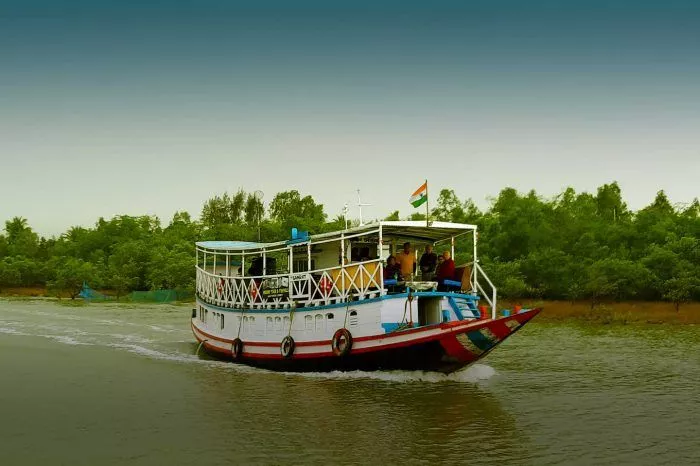- 1 Day Sundarban Tour
Pricing:
- ₹2799 per adult
- ₹1399 for children aged 4-8 years
- Free for children aged 1-4 years (under 48 months)
Facilities Included:
- Welcome Drink:
- Transportation: [Pick + Drop]
- Breakfast:
- Boat Safari:
- Lunch:
- Sightseeing:
- Guide Assistance:
- Snacks and Tea:
- Safety Measures:
- 1 Night 2 Days Sundarban Tour
Pricing:
- ₹4500 per adult (Non-AC room)
- ₹5000 per adult (AC room)
- ₹2250 for children aged 4-8 years
- Free for children aged 1-4 years (under 48 months)
Facilities Included:
- Welcome Drink
- Meals: All Times
- Boat Safari
- Accommodation: AC/ Non Ac
- Cultural Program:
- Visit Watchtowers and Local Attractions
- Safety
- Guided Tour
- Tea/Coffee Breaks
- 2 Night 3 Days Sundarban Tour
Pricing:
- ₹5500 per adult (Non-AC room)
- ₹6500 per adult (AC room)
- ₹2750 for children aged 4-8 years
- Free for children aged 1-4 years (under 48 months)
Facilities Included:
- Welcome Drink
- Meals: (breakfast, lunch, evening snacks, and dinner)
- Extended Boat Safaris: Multiple guided boat safaris
- Accommodation: in AC or non-AC rooms,
- Cultural Program:
- Visits to Key Attractions:
- Expert Guide:
- Tea/Coffee Breaks:

Sundarban 3 Days 2 Nights Package
Immerse in the wild beauty of Sundarbans with our 3 Days, 2 Nights adventure!

Book Sundarban 3 Days 2 Nights
Immerse in the wild beauty of Sundarbans with our 3 Days, 2 Nights adventure!
- 2 Night 3 Days Sundarban Boat Tour
Pricing:
- ₹5500 per adult (Non-AC room)
- ₹6500 per adult (AC room)
- ₹2750 for children aged 4-8 years
- Free for children aged 1-4 years (under 48 months)
Facilities Included:
- All Meals:
- Guided Boat Safaris:
- 2-Night Accommodation: Stay on the boat in comfortable AC or non-AC rooms.
- Cultural Performances:
- Attractions:
- Safety & Security:

Boat Sundarban 3 Days 2 Nights Package
Sail into the wild with our 3 Days, 2 Nights Sundarban Boat Adventure!

Sundarban 3 Days 2 Nights Package
Explore the untamed beauty of Sundarbans with a thrilling 3 Days, 2 Nights boat tour!
How Eco-Tourism is Shaping the Future of Sundarbans

Introduction: How Eco-Tourism is Shaping the Future of Sundarbans
How eco-tourism is shaping the future of Sundarbans is a story of conservation, community empowerment, and sustainable travel. The Sundarbans, the world’s largest mangrove forest and a UNESCO World Heritage site, faces growing environmental threats due to climate change, habitat loss, and unregulated tourism. However, eco-tourism has emerged as a powerful force to protect this fragile ecosystem while supporting local livelihoods. In this article, we explore how eco-tourism is shaping the future of Sundarbans and why it matters for travelers, conservationists, and local communities alike.
Read More:

Understanding the Sundarbans: A Delicate Ecosystem in Need of Protection
The Sundarbans is an intricate network of tidal waterways, mudflats, and mangrove forests spanning India and Bangladesh. It provides habitat for endangered species like the Royal Bengal Tiger, saltwater crocodiles, and a diverse array of bird species. Unfortunately, human activity and climate challenges threaten this unique ecosystem.
Key Environmental Challenges:
- Rising sea levels and increased salinity
- Deforestation and habitat degradation
- Pollution from nearby settlements and industries
- Impact of uncontrolled tourism activities
Eco-tourism offers a solution by emphasizing responsible travel that minimizes environmental impact and fosters conservation efforts.

How Eco-Tourism is Shaping the Future of Sundarbans: Key Benefits
1. Conservation Through Awareness and Funding
Eco-tourism promotes awareness among visitors about the ecological importance of the Sundarbans. By encouraging low-impact visits and education, eco-tourism helps fund conservation projects, including habitat restoration and wildlife protection.
2. Empowering Local Communities
Sustainable tourism creates economic opportunities for local residents through eco-friendly lodging, guided tours, and handicraft sales. This empowerment reduces dependency on harmful activities like illegal logging or poaching.
3. Promoting Sustainable Travel Practices
Eco-tourism advocates for responsible travel methods, such as limiting group sizes, using non-motorized boats, and respecting wildlife habitats. These practices reduce pollution and disturbance in the mangroves.
4. Supporting Scientific Research and Monitoring
Eco-tourism often partners with research organizations, facilitating data collection and monitoring of wildlife populations and environmental health, which helps inform better protection strategies.
Essential Practices for Visitors to Support Eco-Tourism in Sundarbans
Choose Eco-Friendly Tour Operators
Select tour companies committed to sustainable practices. Look for certifications, local involvement, and clear policies on waste management and wildlife respect.
Minimize Plastic and Waste
Carry reusable bottles, avoid single-use plastics, and dispose of waste responsibly. Many parts of the Sundarbans are remote, and litter can severely impact the ecosystem.
Respect Wildlife and Habitat
Maintain safe distances from animals, avoid loud noises, and follow designated paths to minimize habitat disruption.

Stay Safe from Mosquitoes
While eco-tourism enhances the natural experience, the Sundarbans is home to many mosquitoes. Use insect repellent, wear long sleeves, and sleep under mosquito nets.
Long-Tail Keywords to Naturally Include
- Benefits of eco-tourism in Sundarbans conservation
- Sustainable travel tips for Sundarbans visitors
- How eco-tourism supports local communities in Sundarbans
- Best eco-friendly Sundarbans tour operators
- Wildlife protection through eco-tourism in Sundarbans
Internal and External Link Suggestions
- Internal Link Suggestion: Link to a blog post on Best Photography Gear for Sundarbans Wildlife Photography to encourage readers interested in eco-tourism to explore photography tips.
- External Link Suggestion: Link to UNESCO’s Sundarbans World Heritage page or recognized environmental NGOs working in the region for deeper information.

Conclusion: Embrace Eco-Tourism and Protect the Sundarbans’ Future
How eco-tourism is shaping the future of Sundarbans goes beyond travel—it’s a movement toward preserving one of the planet’s most extraordinary ecosystems. By supporting eco-friendly tourism, travelers contribute to conservation, empower local communities, and help ensure that future generations can experience the magic of the Sundarbans.
Remember to stay safe from mosquitoes by taking appropriate precautions during your visit. For an enriching and responsible experience, consider booking through trusted operators.
Also, you can Book the Sundarban Tour At Royal Sundarban Tourism [https://royalsundarbantourism.com/] Powered By Argusdna, [https://argusdna.com/] to enjoy a sustainable and memorable Sundarbans eco-tourism experience.

Join the growing community of eco-conscious travelers shaping the future of Sundarbans—your journey can make a difference.








